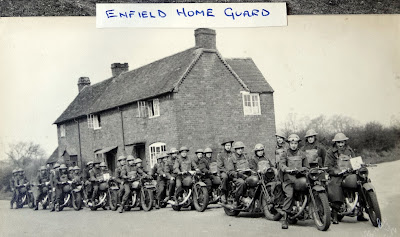 |
| Royal Enfield had its own company of the Home Guard. |
Royal Enfield motorcycles really do appear in a World War II photograph said to show "the Redditch Home Guard."
What's more, there's evidence that the motorcycle-mounted soldiers in the photo are from Royal Enfield's own Redditch factory.
We know that such a unit existed because Royal Enfield boasted of it in its post-war publication "A Proud War Record."
"The Head Works at Redditch had its own Company of the 9th Bn. (Worcester) Home Guard," the book asserts.
The Home Guard formed in 1940, with Britain exposed to invasion. Men too young, too old or too valuable on the production line to send overseas were enlisted in the Home Guard to defend their hometowns against enemy parachutists.
At first there were no uniforms and few guns (and maybe five bullets apiece).
But the Home Guard became well drilled and better equipped. Redditch itself was designated a "tank island," with members of the Home Guard assigned to block German invaders with trenches, fire bombs and, apparently, motorcycles.
The website Birmingham Live posted the photo April 8, describing it as "Royal Enfield despatch rider motorbike and the Redditch Home Guard on Royal Enfield bikes."
Then Royal Enfield Owners Club UK archivist Robert Murdoch posted a version of the same photo May 31 on the REOC's Facebook page, Royal Enfield Owners Club - Est. 1877.
This time the photo was labelled "Enfield Home Guard."
"Here is the Royal Enfield factory Home Guard comprising factory workers in reserved occupations. Unsurprisingly, most seem to be mounted on Royal Enfield motorcycles," Bob wrote with the photo.
I asked him about it. He told me in an email that it came mounted in a page of an album donated to the club by Barry Smith.
Now that's something. Smith was secretary of the Royal Enfield Company from 1959 to 1962, the son of Major Frank Walker Smith, who led the company as managing director, and the grandson of Royal Enfield designer and managing director Bob Walker Smith. He died in 2009.
Barry Smith would have known how to label the photograph correctly.
"I'm sure this photo would be (the part of) the same 9th Battalion provided by the Royal Enfield employees after working hours, which would have been a very long day," Bob wrote.
It makes sense. Where else but the factory would an entire Home Guard unit get Royal Enfield motorcycles?
I shared the higher-resolution version of the photo Bob sent me with Jan Vandevelde, a student of Royal Enfield military motorcycles. What did he see in it?
"I can only see Royal Enfields here. Lots of WD/COs, a KX, a side-valve with a civilian petrol tank. None of the WD/COs has a census number on the petrol tank... " he replied in an email.
The absence of numbers stenciled on the gas tanks of any of the motorcycles in the photo is significant.
"Every vehicle that was purchased by the Army had its own unique census number, which in 1942 was applied in the factory. So these bikes most probably don’t come from one of the Army contracts. At least this is what I think," Jan wrote.
And he saw a lot more that suggested the motorcycles in the photo came directly to the Home Guard from the Royal Enfield factory, rather than government depots.
Three of the motorcycles pictured have civilian style fender license plates, all three of which seem to begin with the letters "DUY."
"DUY was a Worcestershire registration block that was issued during the first years of the war (1940-1941). I have copied the old registration ledgers in Worcester, and this DUY block contains quite a few Works Registrations (numbers that were issued to the 'Enfield Cycle Company' in Redditch)," Jan wrote me.
Specifically, Jan sees DUY905, DUY906 and DUY90-something on three motorcycles in the picture. He sent me his copies of the registration ledgers that show that all of those numbers went to Royal Enfield motorcycles registered to the Royal Enfield Cycle Co.
This includes the DUY90-something, which must have been DUY903 or DUY904, as the ledger book shows that the other final single digits were assigned to lorries or tractors.
In other words, we know these three motorcycles, at least, actually belonged to Royal Enfield.
Jan noted one other reason it's likely the motorcycles were provided by the factory: there seem to be prototypes among them.
The registration ledger shows that the DUY90-somethings were registered in June, 1941. That's too early for the Royal Enfield WD (War Department) CO models Jan sees in the photo. Production CO's didn't come along until Spring, 1942. (The factory could have switched the earlier plates to later vehicles, an alternative explanation.)
Another example: "DUY905 has a WD/CO engine, but the forks are WD/C (with speedometer at the left hand side of the forks). This could be a (flathead) WD/C in which they have put an OHV engine."
It's a detective game, figuring out this photo. What we still don't know is intriguing.
Why was the photo made?
 |
| An idealized version of Home Guard riders on patrol. |
I personally wonder if it wasn't made to serve as the basis of an illustration, something Royal Enfield did often for advertising. Something like this Home Guard photo appears in "A Proud War Record."
The motorcyclists in the illustration are proud, poised and praise worthy. Hopefully that is the feeling the men of the 9th Battalion got from their photo shoot.







































http://myroyalenfields.blogspot.com/2022/07/a-worcestershire-home-guard.html
ReplyDeleteA mention of the Enfield Company. Click here
Delete